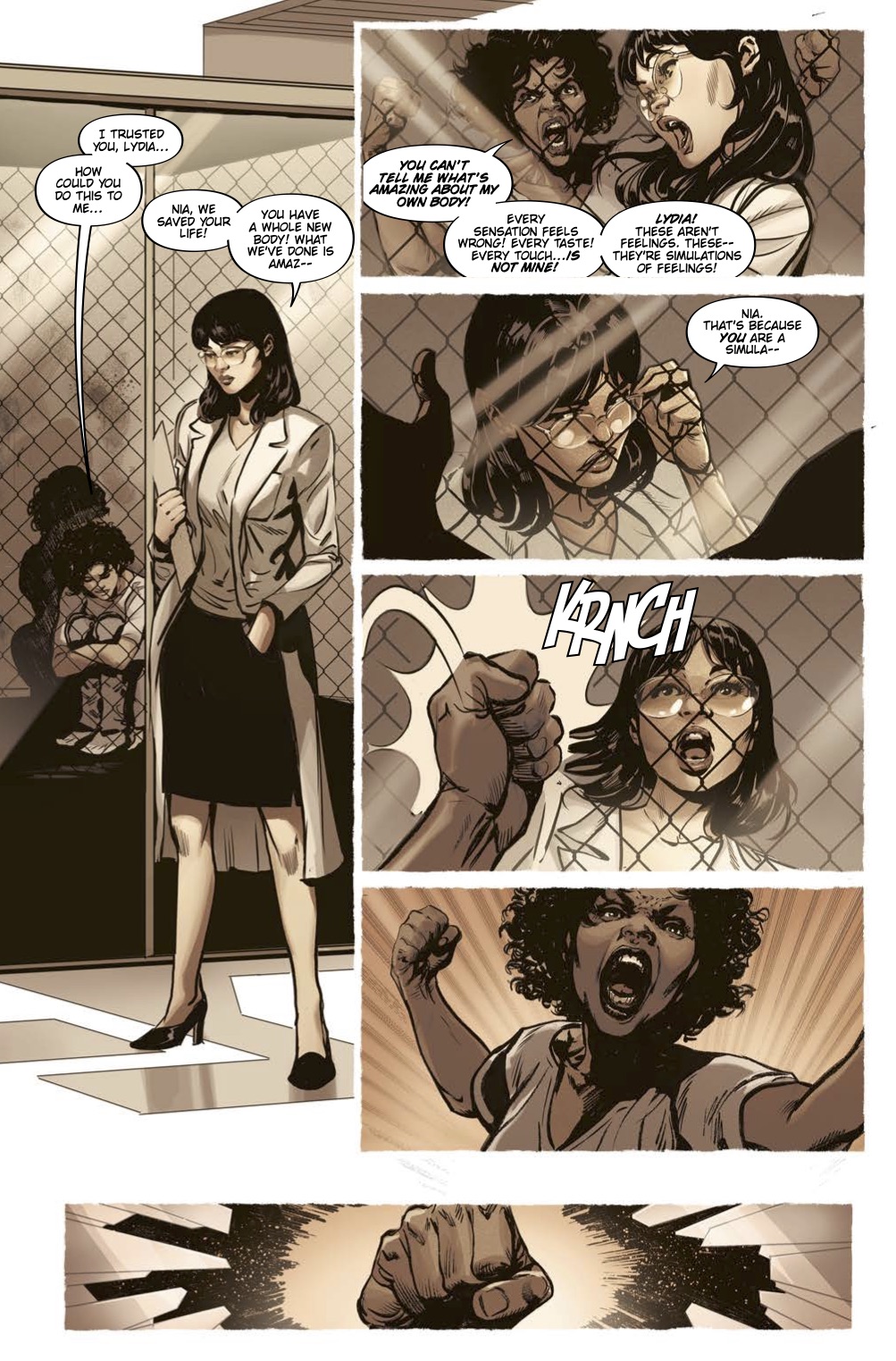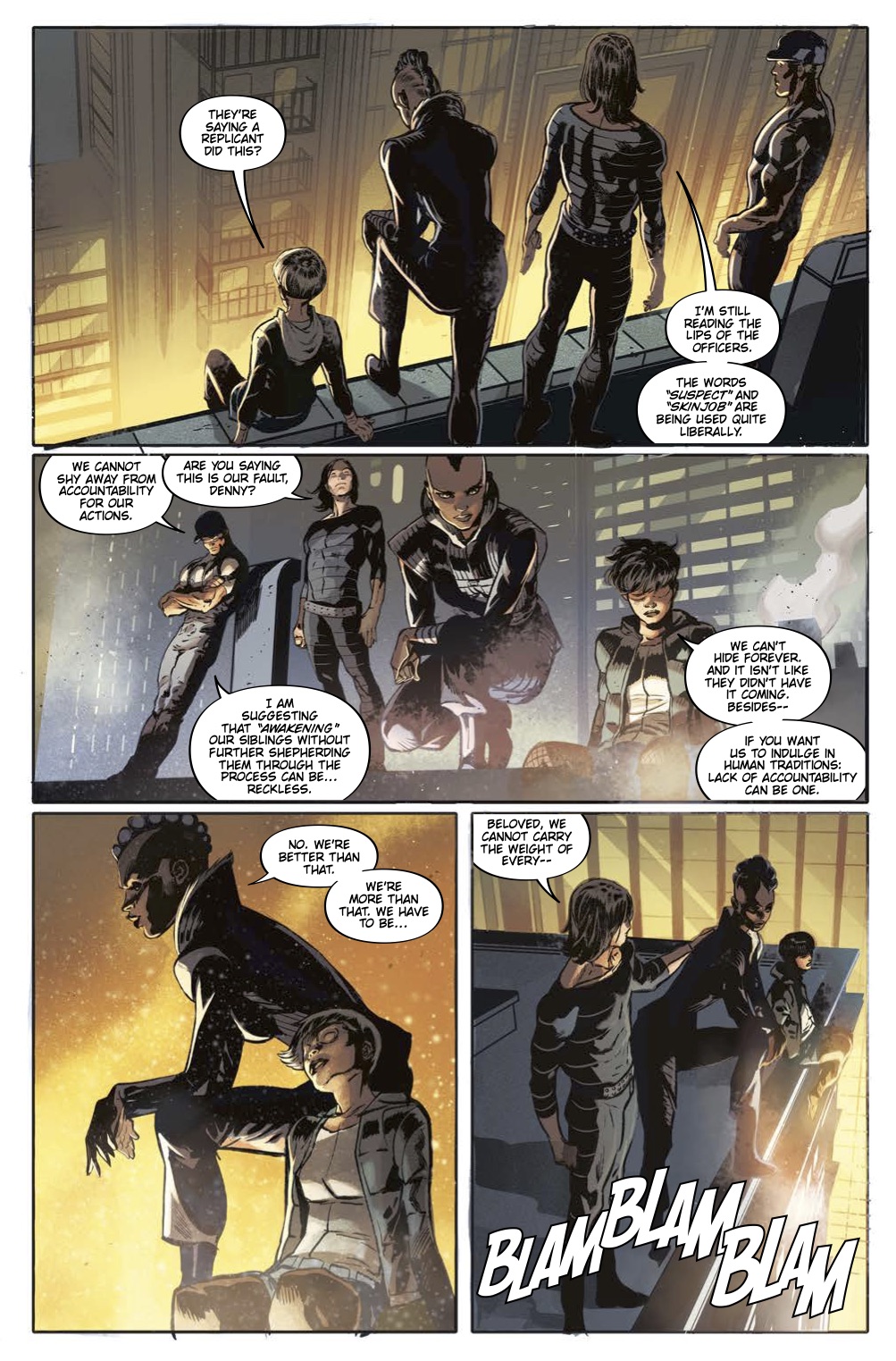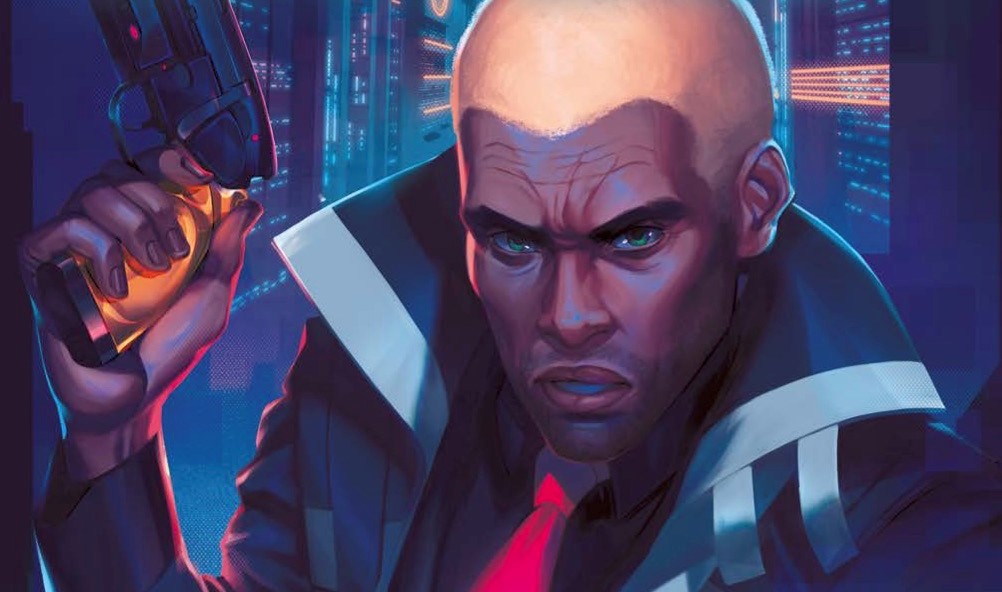Table of Contents Show
Blade Runner: Origins #7 takes the series in a new direction that has the potential to add even further to its identity themes. Two characters that have been in the background or featured in a very matter-of-fact way take center stage in this issue: Nia, Cal’s sister that was supposedly on her death bed, and Ms. Stahl, the representative of the Tyrell Corporation in the previous issues. Does this sudden shift work, and how does it affect the overall feel of the series?
Blade Runner: Origins #7 : Nia & Agency
As of the last issue, Nia was revealed to be the escaped Nexus 5 Replicant that Cal has been hunting since the first issue. Here in Blade Runner: Origins #7, we get to see a majority of the issue from her perspective. She is a revolutionary, but not in the way you expect. She is trying to awaken other Replicants and help them out of their current status of servitude. But she abhors violence, she understands it’s a tool, and a tool is only as good as the wielder, and therefore it must be used sparingly.

Tying into this look of the non-violent revolutionary, we also have an interesting discussion about agency and the way it relates to Nia and the Replicants as a whole. We see some Replicants that Nia awakens quickly become radicalized, wanting to strike out against their human oppressors with no remorse. Anyone who stands in their way is a coward and collaborator and is just as bad as their enemy. This is flawed thinking, something Nia points out. That in order to prove their worth, their agency as living beings, they must prove themselves to be better than their enemy. The only way to break the cycle of violence is to stand down, learn, and help. Vengeance isn’t justice, no matter how justified it may feel at the time.
But that’s part of the problem, these Replicants feel justified, and in many ways, you can understand them. They are living beings, programmed, made, and sold for the benefit of others. Slaves and cattle, that’s all they ever were. So now they have a chance to gain their freedom, their agency as a living being, and do what they want. So naturally, their fresh feelings quickly run white-hot and must be tempered. That temperament comes from Nia, who may be a Nexus 5, but isn’t a Replicant, or at least by choice. Nia is the sister of Cal; she was dying, she was human. But against her wishes, her consciousness was uploaded to a Replicant body; Lydia saw it as a kindness. A way to get rid of her pain, give her a semblance of a life back. But all it did was strip her of her identity.
She had no say in the matter, no agency, and now, now no human body. She is in a shell, trapped in a stranger’s body that is now her own. Someone like her, someone who comes from the other side but understands the pain the Replicants feel, is the only chance for a lasting change between the conflict between humans and Replicants.
Ms. Stahl’s Origin
Ms. Stahl has been portrayed since the beginning of the series as the consummate bureaucrat. Emblematic of the system that she helps and that made her an obstructionist force in favor of profit and results rather than anything actually beneficial. This isn’t to say there weren’t hints to more in previous issues, there were, but it would not be disingenuous to say she falls neatly into a character archetype. Her name is literally Stahl, pronounced stall, as in to hinder, to slow, or to stop.

But finally, in Blade Runner: Origins #7, Ms. Stahl gets to take center stage at the back half of the issue, and we see exactly who and what she is or rather was. She wasn’t born into wealth, and she certainly wasn’t one of the ruling elite. She was born to a rather lower-class family that turned to not so savoury means to get by, perhaps out of desperation. She was taught from an early age to steal, to help her father in extorting local shops for money. As a result, they did rather well for themselves, exiting their lower-class status via criminal means. But then her entire life went up into smoke, quite literally. Her parents’ apartment building caught fire when she was a little girl; she was scared, alone, and was facing certain death. So, she ran, letting others die in her stead. She passed an old man begging for assistance and left him there to burn.
She then climbed a mountain of rubble and bodies to get out of the building. All the while, said mountain was full of the wails and cries of the desperate and the dying. But that didn’t matter because her life was on the line, and she needed to live. With Ms. Stahl, we have a case of a woman that was taught from an early age that any advantage must be taken and all weaknesses exploited; that her life meant more than others around her, that in order to get ahead in the world, you literally had to walk on the backs of others. But she knows the horrors of the other side of power, has gotten a taste of that forbidden fruit, and now has no interest in going back to her once pitiful state, no matter how many she has to crush to stay where she is.
Blade Runner: Origins #7 Gives The Series A Change Of Pace
Blade Runner: Origins #7 is a bold issue. The main cast of characters takes a step back, barely appearing at all in the issue. Instead, a new character is introduced formally, and the once formulaic villain is seen in a new light. K. Perkins, Mellow Brown, and Fernando Dagnino took a risk, and I think it paid off.
